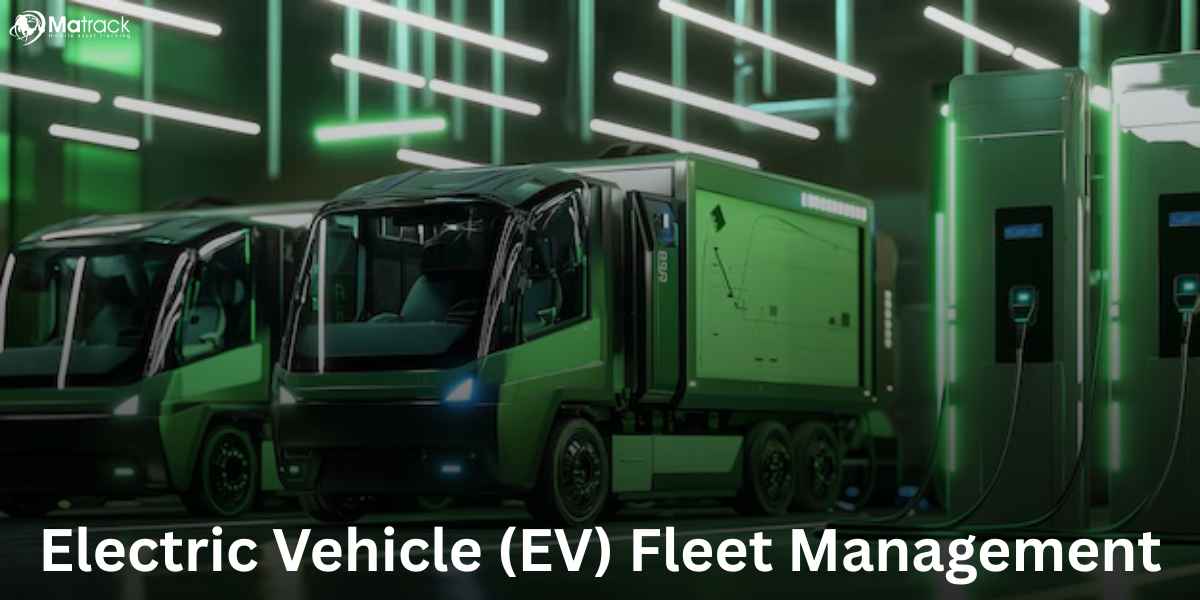Key Takeaways:
- EV fleet management helps businesses cut costs, improve vehicle uptime, and meet sustainability goals by using smart data and technology.
- This is achieved by choosing the right vehicles, designing charging setups that fit daily routes, and using telematics to track operations in real time.
- Software tools add value by connecting charging control, battery health monitoring, route planning, and compliance reporting into one system.
- Matrack ties everything together by offering tracking, dash cams, ELD solutions, and fuel cards that give fleets complete control over safety, spending, and performance.
What is EV Fleet Management?
EV fleet management is the process of controlling, monitoring, and optimizing electric vehicles used in business operations. It covers how companies select electric models, plan charging infrastructure, track vehicle usage, and manage battery health.
It involves using technology and data to ensure every vehicle operates efficiently. This includes telematics systems, route planning tools, and software that monitors energy consumption, charging schedules, and maintenance needs.
The goal of EV fleet management is to increase vehicle uptime, control operational costs, and support sustainable transport. It ensures that businesses get the best performance from their electric vehicles while meeting operational demands.
Related: What is Vehicle Fleet Management?
What Are The Key Features of EV Fleet Management Software?
EV fleet management software provides core features that work together to increase operational efficiency. Each feature addresses a key part of managing electric vehicles while supporting cost control and sustainability goals.
Charging management
The software automates charging schedules so fleets avoid peak energy rates and control electricity costs. Real-time monitoring helps ensure chargers are available when needed and vehicles stay on schedule.
Battery analytics
With battery analytics, managers get clear data on battery health and performance. This supports predictive maintenance and helps avoid unexpected range issues that could disrupt operations.
Route optimization
Route optimization uses traffic, terrain, and energy consumption data to plan efficient journeys. This reduces energy use and keeps vehicles running on time across planned routes.
Cost analysis
The software tracks fuel savings, maintenance costs, and total cost of ownership. These reports give businesses insight into fleet performance and highlight opportunities for further savings.
Compliance reporting
Compliance reporting tools generate documentation for emissions and sustainability records. This makes it easier for businesses to meet regulatory requirements and demonstrate environmental responsibility
How to Implement EV Fleet Management?
Step 1: Assess current fleet operations
Review how your fleet operates today. Identify vehicle usage patterns, daily distances, route profiles, payloads, and idle engine times to understand which parts of your operations suit electric vehicles.
Step 2: Select the right electric vehicles
Choose EV models that match your fleet’s specific requirements. Focus on range, payload capacity, charging speed, and total cost of ownership to ensure vehicles can handle daily routes without interruption.
Step 3: Plan charging infrastructure
Design a charging setup that keeps vehicles ready for use. Decide on the number and type of chargers, such as Level 2 or DC fast chargers, and plan their locations at depots or key points along routes.
Step 4: Coordinate with utility providers
Engage with local utility companies to secure sufficient electrical capacity. Work on solutions that balance charging demand with grid stability and help avoid peak-time energy costs.
Step 5: Install telematics systems
Integrate telematics systems to track vehicle location, energy use, battery health, and driver behavior in real time. This data helps improve route planning, charging efficiency, and safety.
Step 6: Set up a preventive maintenance plan
Develop a preventive maintenance schedule that addresses EV-specific needs. Focus on tasks like brake inspections, tire checks, and software updates to minimize downtime and extend vehicle life.
Step 7: Train drivers and staff
Provide clear driver training on EV operations. Teach drivers how to maximize battery efficiency, use charging stations correctly, and follow best practices for electric vehicle care.
Step 8: Monitor performance and adjust strategies
Track fleet performance using analytics tools. Use the data to refine charging schedules, improve routes, and plan future vehicle upgrades or expansions based on operational needs.
Also Read: What is fleet management plan
What Are The Benefits and Challenges in EV Fleet Management?
| Benefits | Challenges |
| Lower fuel and maintenance costs | High upfront costs for vehicles and charging setup |
| Reduced or zero direct CO2 emissions | Limited public charging infrastructure availability |
| Increased route and charging efficiency | Some EV models have insufficient range for certain routes |
| Easier compliance with emissions regulations | Heavy grid demand from large-scale fleet charging |
Things to Consider Before Choosing EV Fleet Management
Before choosing an EV fleet management solution, it is important to look at factors that will directly affect long-term costs, efficiency, and flexibility. Each of these points plays a key role in ensuring your investment delivers value.
Total cost over time
Consider the full cost of managing the EV fleet, not just the purchase price of vehicles and chargers. Include ongoing software fees, infrastructure maintenance, utility upgrades, and staff training when calculating the budget.
Scalability of the system
Check whether the EV fleet management solution can grow as your fleet expands. A scalable system allows you to add vehicles, manage more charging points, and adopt new technologies without needing to replace the platform.
Software compatibility
Make sure the management software works well with your existing business systems. Seamless integration with dispatching platforms, ERP software, and accounting tools will reduce manual tasks and keep data consistent.
Data security measures
Examine how the provider protects your fleet’s data. Strong security is essential because EV fleet management systems handle sensitive information such as location tracking, charging records, and driver activity.
Flexibility for energy sourcing
Evaluate whether the system supports multiple energy sources. The ability to manage grid power, on-site solar, and other energy inputs can help reduce costs and improve sustainability.
Quality of technical support
Consider the level of customer service the provider offers. Reliable technical support is essential to resolve software, hardware, or integration issues quickly and keep fleet operations smooth.
Related: 8 Best Fleet Management Systems
Why Matrack Is the Best Option for EV Fleet Management Operations?
Matrack provides a complete solution for EV fleet management that combines advanced tracking, safety tools, compliance systems, and cost control features. Each capability works together to help businesses operate efficiently and with full visibility.
Fleet tracking
Matrack’s fleet tracking system delivers real-time data on vehicle location, battery status, route progress, and energy consumption. This level of detail helps managers monitor operations closely, respond to issues quickly, and keep vehicles on schedule.
Fleet dash cam
Matrack offers integrated dash cam solutions that record clear video of driving activity. These cameras promote safer driving, provide evidence in case of accidents, and help protect businesses from false claims or disputes.
ELD solution
Matrack includes a compliant ELD system for fleets that need to track driver hours and maintain records for regulatory purposes. This feature simplifies hours-of-service logging and helps businesses avoid fines related to non-compliance.
Fuel card
Matrack’s fuel card gives businesses a simple way to control fuel spending and monitor transactions. The card integrates with fleet data to provide complete visibility over expenses, supporting both EV operations and mixed-fuel fleets.

